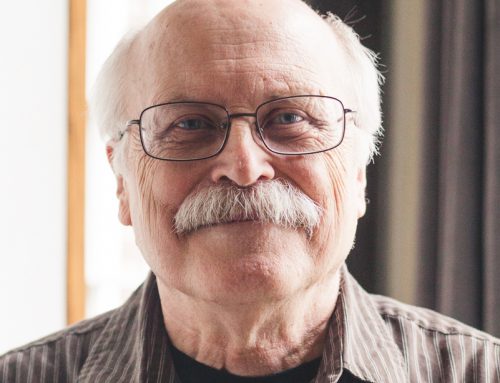What follows is Ron Julian’s last talk to Reformation Fellowship, given online on Easter Sunday, April 12, 2020.
***
When the apostle John comes to the end of his Gospel where he talks about the death and resurrection of Jesus, he emphasizes that he himself was a witness to everything. Now, we know that John never refers to himself by name. He never says “I” or “me.” Instead, he speaks of “the disciple whom Jesus loves” or “the disciple who is testifying to these things.” But there is no doubt that John is talking about himself, that he was there and saw it all.
John was there in the upper room. Jesus told the disciples that one of them would betray Him, but only John was told that the betrayer would be Judas.
John was there at the cross. He can testify that Jesus was truly dead. He saw the soldier pierce Jesus with a spear, when blood and water flowed out. He saw that the soldiers did not break Jesus’ legs, because they examined Him and saw that He was already dead. Jesus was dead! John saw it! As John says about himself,
And he who has seen has testified, and his testimony is true; and he knows that he is telling the truth, so that you also may believe” (John 19:35).
Of all the Gospel writers, only John tells us that when Peter ran to look at the empty tomb, John went with him. John ran ahead. John got to the tomb first and looked inside. Then Peter arrived and went in. And John tells us that after he himself saw the empty tomb, he believed.
John was there when Mary Magdalene told them that Jesus appeared to her.
John was there when Jesus first appeared to the disciples themselves.
John was there when Jesus appeared to Thomas.
John was there in Galilee when Jesus came to them while they were fishing. After the strange man on the shore yelled at them to cast their net on the right side of the boat, it was John who told Peter, “It is the Lord.” And later, after breakfast, when Jesus breaks the news to Peter that one day he would be executed, John was walking up behind them. Peter pointed at John and asked Jesus, “What’s going to happen to him?” Jesus said, “If I want him to remain until I come again, what is that to you?” And so John has to explain, “You know, there is a rumor going around that the disciple whom Jesus loved won’t die. That’s not what Jesus said”—again, emphasizing that John was there, a witness to all these things.
And then John makes a final statement about this guy, this guy who walked behind Jesus and Peter, this guy who saw and heard all these things, this disciple whom Jesus loved, John says:
This is the disciple who is testifying to these things and wrote these things, and we know that his testimony is true” (21:24).
If it wasn’t clear before, it is clear at the end. The disciple whom Jesus loved is the author of this Gospel. And he is telling the truth.
Now, John is ultimately saying that everything he wrote in the Gospel is true: the other miracles that he tells about, turning the water to wine and the raising of Lazarus, and so on. But he particularly emphasizes that the story of Jesus’ death and resurrection is true. Jesus really died. John saw it. The tomb was empty. John saw it. Jesus appeared to the disciples multiple times. John saw it.
Why this repeated insistence? I think for John, being an eyewitness to the resurrection is important for at least two reasons. And both reasons are very important to us.
First of all, a major theme in John’s Gospel is eternal life, the conquest of death. And Jesus’ death and resurrection are deeply connected to the eternal life that He promises. Early in the book, Jesus makes the claim that the power of life or death, mercy or judgment, is in his hands. He says:
…an hour is coming, in which all who are in the tombs will hear His voice, and will come forth; those who did the good deeds to a resurrection of life, those who committed the evil deeds to a resurrection of judgment. (5:28)
Jesus later says that he is the bread of life. He is the bread, the food, that truly gives eternal life (metaphorically speaking). And what is that food? It is his flesh, His body broken on the cross, His death and resurrection, that conquers death for His people.
The second greatest miracle in the Gospel of John is the raising of Lazarus. We hear of Lazarus’ death. We see the deep grief of his family. We see Jesus say to his sister, “I am the resurrection and the life; he who believes in Me will live even if he dies” (11:25). And then, as if to show it’s true, Jesus raises Lazarus from the dead. This miracle, the raising of Lazarus, is the talk of Jerusalem and the surrounding countryside. Only John’s Gospel brings this out.
During the triumphal entry, when Jesus enters Jerusalem, John tells us that the crowds were there cheering because they knew about the miracle of raising Lazarus. And then we have the greatest miracle, the resurrection. Just before Jesus dies and rises again, He tells His disciples that “because I live, you will live also” (14:19). Jesus defeated death both for Himself and for His people. That is one reason why it is so important that John really saw it, that the resurrection really happened.
The second reason that John’s testimony about the resurrection is so important is that life comes to those who believe. And most of those who believe, like us, must believe based on the testimony of John and the apostles. John makes a summary statement about his reason for writing the book. It makes his purpose very clear. Why did Jesus perform signs like turning the water to wine, raising Lazarus, and most importantly, rising from the dead? And why does John emphasize the truth of his testimony about these signs? Here is what he says:
Therefore many other signs Jesus also performed in the presence of the disciples, which are not written in this book; but these have been written so that you may believe that Jesus is the Christ, the Son of God; and that believing you may have life in His name. (20:30-31)
This is why John cares so much about telling us that he saw these things happen. God calls us to believe that He sent Jesus, that Jesus’ death and resurrection is for us. And John’s testimony gives us good reason to believe that it happened. John says it multiple times: I am telling you what I saw so that you might believe and get eternal life. We didn’t see it, but John did, and he’s telling us about it so that we can believe because those who believe are those who get eternal life in the end. And John’s testimony gives us a good, solid foundation for that belief.
In the end, we are talking about life and death issues. Today, this Easter Sunday, you and I are not meeting in person, because of events that have a lot of us thinking about death. (I know I have had it on my mind a lot lately.) As Christians, we know that the reality is much greater than the world around us sees. The stakes are higher than most people know. On the one hand, we fear not just death but judgment. Every one of us needs God’s mercy or we are eternally lost. On the other hand, we know that responding to God with belief is the doorway to freedom from death and judgment forever. So the stakes are very high indeed. And that is why it was so important to John that we know: He saw Jesus die. He saw Jesus live again. He is telling us the truth. And we should believe him and find life eternal.
This article first appeared in the Spring 2021 issue of Colloquy, Gutenberg College’s free quarterly newsletter. Subscribe here.






